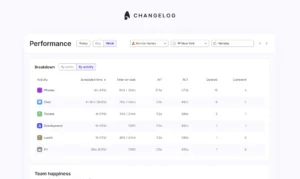
When does a contact centre need WFM?

Does your contact centre need workforce management software? What are the triggers that imply it’s the right time to get WFM onboard and what exactly will WFM do for you?
A contact centre by nature is always trying to match the number of people it has available (capacity) with the number of customer queries that are coming through (inflow).
A Monday morning is very different from a Saturday afternoon for a number of reasons. While inflow will be higher on a Monday morning, there will also be more people available and willing to work than a Saturday afternoon.
Workforce management software allows you to optimise your contact centre, so that you have enough people working on the right things to avoid your customers having to wait for responses.
What is workforce management software (WFM)?
Workforce management software (WFM) is typically comprised of four main components:
- Predicting inflow and capacity requirements through forecasting. This is typically done through integrating into ticketing, CRM systems and telephony providers to pull historical data to inform what future contact centre arrival patterns will be. The WFM then converts expected ticket volumes to the number of people needed, using a range of statistical models.
- Building schedules based on required capacity. Using the forecasted number of people required to meet customer demand and the internal constraints around contracted hours, skills and fairness, WFM automatically generates optimal schedules determining both working hours and the distribution of tasks across the day. More information on call centre forecasting is available in our resources section.
- Reacting to changes in inflow or capacity as they happen. It always helps to plan in advance, but in a contact centre environment, things change quickly. Either you have more or less customer inquiries coming through, or your capacity changes through illness, holidays, or shrinkage from other priorities. As these changes happen in real time, WFM allows you to re-optimise with ease to consistently meet service goals.
- Understand team and agent performance. Data sits in disparate places and it can be hard to have a source of truth of how performant a support team is. WFM displays this data and uses it for more accurate planning.
Benefits of WFM for call centres
- Delight customers with exceptional experiences. Good service is determined by two things: the speed of service and the quality of service. WFM allows you to achieve both through having the right people working on the right things at the right time.
- Manage employees in a fair and reliable way. Equip your teams with the data that ensures they’re working on the right things, and distribute working hours and tasks in a fair and transparent manner to avoid burnout and attrition.
- Plan for different scenarios through utilising data. Whether you’re planning for a hiring spree, product release, sale or special event, the data that sits within WFM allows you to assess the trade-offs for different scenarios; whether you need to relax your response time targets or hire more people.
When you need WFM
There are many clear triggers driving a need for WFM. Usually, as a contact centre becomes more complex, WFM is needed to keep the team organised and optimised to meet customer facing and internal goals.
More people
The biggest driver for needing WFM is organisational scale. Once a support team surpasses 30 people, WFM becomes top of mind. Additional headcount comes with different working hours, different contracts, preferences and managing this on a spreadsheet becomes difficult.
New channels
WFM is most popular for contact centres that offer phone, chat and other live channel support. This is because of the urgency of requests that come through for customers. As a support team becomes omnichannel, WFM becomes a must have to balance SLA performance for live channels in addition to managing backlogs for non-live channels.
Extended working hours
As you extend your working hours so customers can get in contact with you, as well as to smooth out inflow arrival patterns, WFM becomes necessary to distribute shift patterns and optimise intraday tasks.
Labour law compliance
In certain geographies where labour laws are strict, specific to overtime or specific contract types, WFM is necessary to track actual working hours to ensure payroll is correct and HR compliance is adhered to.
New technology
Introducing new technology, specifically ticketing or telephony systems, can be a good trigger for adopting WFM. Usually a change in technology stack is driven by looking for efficiency gains and WFM helps connect different systems together to optimise your team.
Want to run a more effective contact centre?
Speak to us about WFM.



